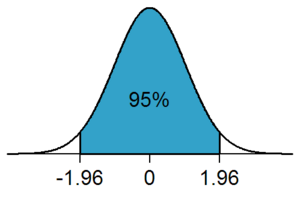Statistical significance facts for kids
When we study things using numbers, like in Statistics, we often look at different measurements called variables. Sometimes, we want to know if a result we got is truly important, or if it just happened by luck. If a result is very unlikely to have happened by chance, we call it statistically significant. This means it's probably a real finding!
We use special tests called Statistical hypothesis tests to figure out if something is statistically significant. These tests help us decide if our findings are reliable.
Contents
What is Statistical Significance?
Imagine you're doing an experiment. You want to see if a new plant food makes plants grow taller. You give the food to one group of plants and plain water to another. After a few weeks, the plants with the new food are taller. Is this because of the food, or just a coincidence?
- Statistical significance helps us answer this.
- It tells us the probability (or chance) that our results happened randomly.
- If this chance is very small, we say the results are significant.
- This means the plant food probably did make a difference!
The Idea of "Chance"
Think about flipping a coin. If you flip it 10 times and get 5 heads, that's pretty normal. But what if you get 10 heads in a row? That's very unusual! It's still possible by chance, but it's much less likely. Statistical significance works like this. It helps us decide when something is so unlikely to be by chance that we should pay attention to it.
Who Came Up with This Idea?
The idea of statistical significance started with a smart scientist named Ronald Fisher. In 1925, he wrote a book called Statistical Methods for Research Workers. In it, he talked about "tests of significance."
- Fisher suggested a special number: 0.05, or one in twenty.
- He said if the chance of something happening randomly was less than 0.05, you could "reject" the idea that it was just luck.
- This "rejecting" means you believe your finding is real.
Later, in 1933, two other scientists, Jerzy Neyman and Egon Pearson, added to Fisher's ideas. They suggested that this special number (like 0.05) should be chosen before you even start collecting your data. They called this number "α" (alpha).
Is the 0.05 Rule Always Used?
Even though Ronald Fisher first suggested 0.05, he didn't mean it should always be the rule. In a later book in 1956, he said that the level of significance should change depending on the situation. For some studies, a different number might make more sense. It's about choosing the right level for what you are studying.
See also
 In Spanish: Significación estadística para niños
In Spanish: Significación estadística para niños


